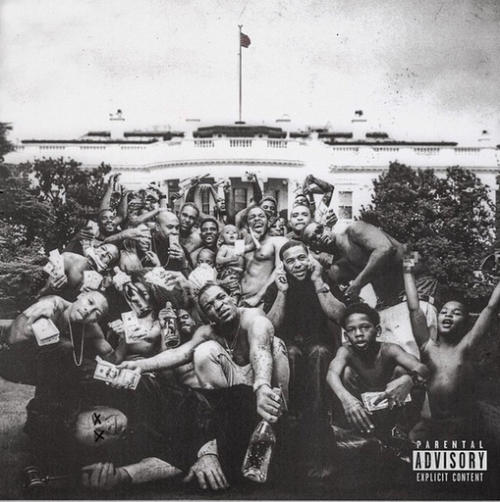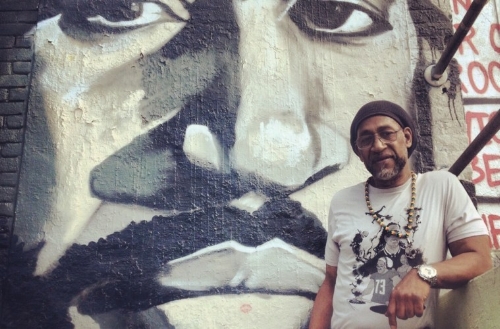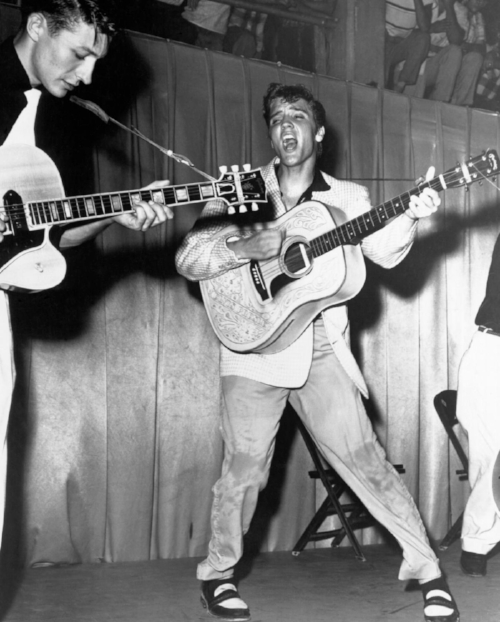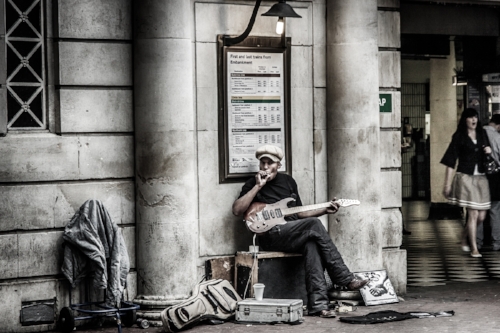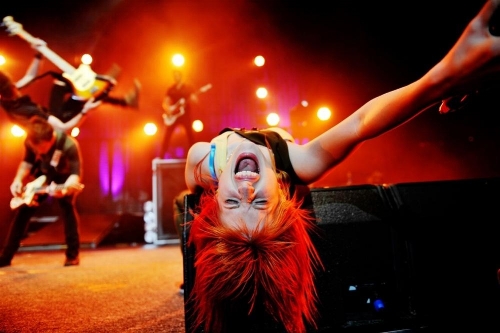FEATURE:
Hip-Hop at Forty-Four:
IN THIS PHOTO: The album cover of Eric B. & Rakim's 1987 Hip-Hop masterpiece, Paid in Full
Street Prophets: Musical Progression and Social Inertia
________
IT is typical of Google that, when searching for results…
pertaining to the forty-fourth anniversary of Hip-Hop; the first options one finds are articles relating to their commemorative ‘doodles’ – a special design/interactive tool that appeared on their search engine a couple of days back. BBC Radio 6 Music celebrated the birth and evolution of Hip-Hop (Hip Hop Hooray) with a day of special programmes yesterday. It was a remarkable, authoritative and passionate examination of a genre that began, pretty much, from one man: Clive Campbell. Better known as DJ Kool Herc; he hosted a back-to-school party in the Bronx, New York on 11th August, 1973. That single, momentous event probably didn’t seem epic or groundbreaking at the time - but it has been credited as the time Hip-Hop was recognised as a genre. Defined by mixing, heavy beats and acute sampling/scratching: it started with modesty but certainly lit a fuse. It would a little while until the first commercial Hip-Hop album - Sugarhill Gang’s Rap Genius - was introduced to the public (in 1979).
IN THIS IMAGE: Ronald Reagan; who was President of America when Hip-Hop assimilated into the mainstream
There are debates as to whether forefathers pre-dated DJ Kool Herc and whether someone else snuck in and sowed the seeds. Conventional wisdom credits DJ Kool Herc, Afrika Bambaataa and Grandmaster Flash as the ‘Holy Trinity’ of Hip-Hop. It is debatable which had a greater effect on the explosion and noticeable nature of Hip-Hop: that back-to-school pioneering event from DJ Kool Herc or the social dissatisfaction that arrived when President Reagan came to the White House in 1981. There were murmurations and groundbreaking albums happening before that time – Rap Genius was the first time Hip-Hop ascended to the mainstream – but there was an acceleration and proliferation of outraged voices stepping up after Reagan’s appointment. I will talk about some of the best albums of the genres and the way the genre has evolved over the years but, for now, a social study. There is a haunting and troubling symmetry when we celebrate Hip-Hop’s birth. The movement/genre recruited its faithful off of the back of governmental ignorance and social poverty – the fact the community, the black community, for the most part, were being trodden on.
By the late-1970s; there was a hyperinflation of the racial divide, social inequality and political tension. Regan’s appointment to office was not exactly the turnaround and redemption many had wished for – being a Republican; he was unlikely to prioritise those less-well-off and struggling. That, back in 1981, caused greater division and cracks in the fabric of U.S. society. Out of the tensions and divides grew a band of artists who articulated, with passion and intelligence, the dissatisfaction and anger being felt by the people of America. Again, we assume it applies to the masses but it was the minority (the black community) who were worst affected – making it seem rather racially-motivated and oppressive. Of course, the whole of America was feeling strain but, as is the case now, there was racial divisionism and social alienation. The affected minority were not getting their voices heard: Hip-Hop was the counterculture explosion that gave its boldest and bravest the platform on which to campaign and sermonise.
IN THIS PHOTO: Scenes of the violence in Charlottesville, Virginia/PHOTO CREDIT: Samuel Corum, Andloua Agency and Getty Images
I mentioned how there was a rather ironic appropriateness we are celebrating the formation of Hip-Hop. One cannot ignore the news and the horrifying scenes coming out of Virginia. It is hardly conceivable what we are seeing happening in Charlottesville right now. Look at a BBC article and, be forewarned, there is some upsetting detail. One woman has been killed and many injured after violent clashes and terrorism – a car ploughing through a crowd of people. The sight of people being tossed through the air like a discarded tissue is enough to turn the stomach and cool the blood. I am not sure as to the exact reason for provocation but far-right white ‘supremacists’ must have been orchestrating and planning this riot for many months. Whether motivated by President Trump’s rhetoric concerning making America 'great again' – there has been nothing that could justify or rationalise this insane and degraded event. One, sadly, assumes there are racists in certain parts of America – the least-evolved and backwoods parts of inbred states!
IN THIS PHOTO: A shocking image from Charlottesville/PHOTO CREDIT: AP
The animals of Charlottesville that have brought the town into disrepute care not for human life or morals: their intention was to show, in some twisted way, why whites are a superior race. Trump’s response to the atrocities has been piecemeal and pathetic! In a rather aloof and unconvincing way; he has condemned the far-right and made it clear America will not tolerate such happenings. That is funny as one could easily blame Trump for this happening in the first place. If he wants to unleash "fire and fury" (as he promised the leader of North Korea, recently) then why not direct it squarely at the abdomens of the racists?! I say ‘abdomens’, because one assumes their brains and genitals are too microscopic to be affected by any weaponised reaction. It is sickening, in 2017, having to witness such hatred and division – that sound familiar?!
IN THIS PHOTO: President Donald J. Trump
If anything; it is worse now than it was at the peak of Hip-Hop. I am confident the reaction from the music world will be swift and unforgiving – barrels being unloaded in the direction of the guilty and Trump. The backlash and outrage on social media have proved how these ‘people’ – that can be seen in their modernised K.K.K. outfits – do not speak for the rest of the world. Even if these riots are confined to a small part of America: how can we be sure it will not spread and inspire like-minded factions to mobilise a similar battalion in another part of the nation?! We can’t, you know, but it seems shocking we should have to contemplate. In the late-1970s/early-1980s, there was balkanisation, economic gulfs and neighbourhood poverty – once-proud areas being reduced to ghettos because of the government’s cold and ignorant views of America. They, then, were unaware of ‘real’ American and how the honest, hardworking citizens lived. It seems, forty years down the line, they are as deluded and naïve as ever.
IN THIS PHOTO: Former President Barack Obama
One knows Trump will do nothing to quell the venom and assured his people – the fact his predecessor, Barack Obama, presently and retrospectively, seems to offer more hope is a sign of how scary Trump is a President. I shall get away from the issue but I know the titans of Hip-Hop will not let this one go. One imagines the likes of Kendrick Lamar, Prophets of Rage and Run the Jewels are inking up their pens and scribbling furiously. I will return to the social divisions and stagnation later but, before coming to the best Hip-Hop albums through the years, I wanted to source an article I have just discovered. Talking about Hip-Hop’s pioneer, DJ Kool Herc; a piece from The Guardian (in 2011) highlighted how much the Hip-Hop community owes to their forefather. Suffering illness during this time; the piece scorned those who did not play benefits and raise money to fund Herc’s treatment:
“There are few pioneers of any musical form who could truly be considered the master architect of a genre – but Herc has that distinction. Hip-hop doesn't just have a family tree, it has a birth certificate: the hand-drawn flyer for the party Herc threw in the basement of 1520 Sedgwick Avenue in the Bronx on 13 August 1973, which so many people turned up to, they had to move it outside, to the nearby Cedar Park. His "merry-go-round" approach – extending the percussion break by playing a second copy of the same record on one turntable as soon as the break had finished on the other deck – gave the world the concept of the breakbeat. Breakdancing, rapping over breakbeats, sampling and loop-based dance music all began that night. Although he is generally seen alongside Afrika Bambaataa and Grandmaster Flash as one third of hip-hop's founding "holy trinity", Herc is first among equals. While Bam was the "Master of Records", his encyclopaedic knowledge of different music adding to the emerging genre's stylistic and sonic palette, and Flash was the innovator whose aptitude for electronics enabled his invention of cutting, cueing and (perhaps: his protege Grand Wizard Theodore claims the invention, though Flash demurs) scratching, Herc was the one who laid the foundations on which they built.
Yet unlike practically everyone who followed him, Herc did not manage to monetise his innovations. Bam and Flash both formed groups with rappers, got signed to key independent labels, and made worldwide hit records. By contrast, Herc was more about the size of the sound system and the atmosphere of the parties he threw, neither of which were things he could duplicate and sell. He stayed in the rec rooms and parks, rocking the beats for the people of hip-hop's epicentre, paying little attention to DJ innovators or the politics of the record industry. Maybe he paid the price for not trying to forever stay on the cutting edge of the genre he accidentally founded: but if you were putting it in the sort of language rappers have tended to use down the years, he never sold out, and he kept it real. His prize for this was a ton of respect, but virtually no cash.
IN THIS PHOTO: Run-D.M.C. and Posse captured in Hollis, Queens (New York) by Janette Beckman in 1984
With the honourable exceptions of Public Enemy and the Chemical Brothers, it looks like pretty much anyone involved in the business of hip-hop, breakbeats or sample-based music owes Herc big time. Jay-Z once rapped that his approach to the industry was to make it pay for the way it mistreated hip-hop's innovators ("I'm overchargin' niggas for what they did to the Cold Crush," he wrote in Izzo, referring to the Cold Crush Brothers, whose leader, Grand Master Caz, had his rhymes used by the Sugar Hill Gang on the first ever rap single) – but words only go so far”.
I will not sub-categorise and headline the segments of this piece but one must forgive that lack of discipline – the fists are still clenched reading the updates coming out of Virginia. Although there is utter f*cking chaos and insanity happening in the U.S. – nothing new there! – it seems like a new, intent wave of Hip-Hop will form. There have been pieces that have studied the etymology of Hip-Hop and the neighbourhoods/people that helped build its foundations – and ensuring it reached the masses. I know the next year-or-so will lead to some explosive and pioneering Hip-Hop albums.
To me, the best Hip-Hop albums were created in the 1980s. It is not shocking considering the factors that contributed to the rise of the genre – artists reacting to the dislocation and instability around them. Aside from confident raps, scratching and socially-aware lyrics: one of the key corners of the Hip-Hop sound has been sampling. It is common in almost all of the best Hip-Hop albums of all time. During the 1980s, there were some fantastic Hip-Hop albums springing up. Criminal Minded by 1987; Run-D.M.C.’s Raising Hell; 3rd Bass’ The Cactus Album; LL Cool J’s Bigger and Deffer. Those are all enduring and defining works that have survived time and influence artists today. One of the biggest albums of the decade – that did not necessarily go overboard on sampling – is/was N.W.A.’s Straight Outta Compton. A humorous album that many felt raised more hell than it did answers: it was provoked and propelled by the same anger and problems that kick-started the Hip-Hop movement. It is an angry and evocative work that remains the group’s most-famous record. Look at those heavyweight Hip-Hop-samplers and I bring to you Beastie Boys, De La Soul; Public Enemy - and Eric B. and Rakim. The latter can be seen as one of the first albums to use sampling in such a way as to unify disparate genres and artists.
IN THIS PHOTO: The cover art to Beastie Boys' album, Paul's Boutique
Paul’s Boutique arrived in 1989 and many can argue it is a finer album. Paid in Full came two years earlier and is considered one of the greatest albums ever. It, not only gave Hip-Hop artists the confidence to use sampling in their work, but directly nodded to where the genre came from. One of the most remarkable things about Hip-Hop is the fact it is not an organic and lab-created style of music. Paid in Full is credited as a landmark album of Hip-Hop’s golden age. Rakim's rapping, which pioneered the use of internal rhymes in Hip-Hop, set a higher standard of lyricism in the genre and served as a template for future rappers. The album's heavy sampling by Eric B. became influential in Hip-Hop production. It is a benchmark, for sure, and one that assimilated Jazz textures and multiple sounds into the Hip-Hop boiling pot – a gauntlet that their contemporaries learnt from and integrated into their own work. 3 Feet High and Rising arrived (in 1989) and was another one of those late-1980s albums that took from Paid in Full and nodded to those golden pioneers.
IN THIS PHOTO: De La Soul
De La Soul employed humour, a unique positivity and uplift that seemed to contrast a lot of the Hip-Hop material at the time. Fellow Hip-Hop legends like Public Enemy would take a more direct and aggressive road to realisation – De La Soul seemed like their Angel (to The Devil), The skill and breadth of De La Soul’s sampling meant 3 Feet High and Rising was listed as one of the finest albums of the 1980s. Jazz, Jazz-Rock and Pop were all poured into the mix. If not as socially-conscious as other albums of the time: it balanced humour and seriousness; put disparate songs – Hall and Oates, Steely Dan and George Clinton were all sampled – together in one. Beastie Boys’ 1989-album, Paul’s Boutique shouldn’t have received the mixed critical reception it did. Considering the like of De La Soul and Eric B. and Rakim had shown how accessible heavily-sampling albums could be; there was a comparative lack of empathy towards the New York trio’s masterpiece. It took years for true acclaim and realisation but, in that wonderful era, it seemed like a natural thing. Using different samples than De La Soul:
IN THIS PHOTO: Public Enemy
Using different samples than De La Soul:Beastie Boys were the vocal/lyrical link between Public Enemy and De La Soul. They had the anger and swaggering attitude but laced lashings of wit and humour into their music. Their rhymes are legendary and their rapping ability cannot be faulted. Hip-Hop artists at the time were using older styles of music and modernising them for new audiences. The same way we can trace modern Rock back to Rock and Roll of the 1950s: one can look at styles like Jazz and Soul as vanguards and inspirations for Hip-Hop. The fluidity and experimentation of Jazz seemed like the natural parent of a genre synonymous with its flows, inventiveness and boldness. It was Public Enemy’s magnum opus, It Takes a Nation of Millions to Hold Us Back. It seems strangely prescient and clairvoyant. An album, nearly thirty years on, seems to represent a sense of racism and outrage.
With Chuck D still in circulation (with Prophets of Rage) one imagines his mind is starting to work on new material. In 1989, the Hip-Hop world had not witnessed anything as articulate, groundbreaking and impactful as Public Enemy’s masterpiece. Maybe N.W.A. had the same anger and aggression but did not channel it into anything as fascinating and relevant as It Takes a Nation of Millions to Hold Us Back. With this L.P; The band wanted to write a Hip-Hop equivalent of Marvin Gaye’s What’s Going On. Whilst their debut, Yo! Bum Rush the Show was largely shunned in favour of the R&B/Rock mainstream in 1987 – there was no ignoring their follow-up in the wake of a Hip-Hop takeover. The Bomb Squad, the group’s production team, produced thick layers to compliment Chuck D’s fiery lyrics; Flavor Flav’s lighter interjections and a myriad of sounds – breakbeats and scratches; incredible samples and some of the most intense performances on record. It remains one of the best albums of all-time and propelled Hip-Hop into the 1990s.
Not only did It Takes a Nation of Millions to Hold Us Back inspire a generation and unify ample samples with a unique identity: the album, in itself, has been sampled by the likes of Madonna (Justify My Love) and Beastie Boys (Egg Man). Not to fly through the ensuing three decades but we have covered the best Hip-Hop albums. The 1990s picked up the mantle and, whilst social concerns and divisions were not the same as the decade previous; the legacy laid down by Beastie Boys and Public Enemy gave contemporaries the confidence to use more sampling and push boundaries. Nas’ Illmatic, Dr. Dre’s The Chronic and A Tribe Called Quest’s The Low End Theory took the origins of Jazz and Hip-Hop and updated it for the early-1990s. One can bring in Funk and Soul that, together with Jazz, relies on a sense of flow, improvisation and rhythm – which were being appropriated and adapted by the Hip-Hop masters of the 1990s. Mos Def’s Black on Both Sides and Lauryn Hill’s The Miseducation of Lauryn Hill were two of the defining works of the late-1990s.
IMAGE CREDIT: Roman Genn
Many assume Hip-Hop to be male-dominated and, whilst true to an extent, Hill’s sole solo album showed there was a generation of female innovators unafraid to join the male-heavy landscape of Hip-Hop. Hill, like her peers, addressed issues affecting her people/community but looked at love and personal demons. She showed it was possible to mix social commentary with more traditional songs and create a stunning work of art. Hill was bringing in Reggae, Roots and Soul (more than Jazz and Funk) – showing how many styles Hip-Hop was inspired by. As opposed to the crate-digging samplers of the 1990s – Lauryn Hill was among a new breed relying more on original compositions but still being innovative and expressive with regards sounds and genres. Aside from the occasional piece of genius sampling album – DJ Shadow’s Entroducing…… in 1996 – the more modern brand of Hip-Hop was defined by a grittiness and directness.
More in common with the acceleration and passionate deliveries of Public Enemy: the best Hip-Hop albums of the '00s have retained the affectionate nods to the past but updated Hip-Hop. Take modern geniuses like Kanye West and Eminem and you hear them dip into the annals of music’s past and scatter Soul, Rock and early-Hip-Hop samples into their music. Eminem is one of the few white Hip-Hop artists of the last to hit the mainstream in the last few decades – showing it is a genre that is not confined in terms of race. Social poverty affected the black community, and still does, in the 1980s – hence its popularisation and explosion – but modern Hip-Hop artists are reacting to the breakup and fragmentation in their nation – something that affects everyone. I have mentioned mostly American artists but, aside from a few British acts like The Streets, the most compelling Hip-Hop albums from all time have been American.
Eminem’s The Marshall Mathers LP arrived right at the start of the '00S and mixed humour, outright aggression – the author lambasted for his homophobic, misogynistic and sexist lyrics – and incredible confidence. The extraordinary raps and incredible flows made the album of the defining works of the decade. The likes of Eminem and Kanye West were addressing issues affection society of the time. Eminem, when he was not rallying against lovers and accusers, was talking about the pressures of fame and nature of popularity. Kanye West, on The College Dropout, talked about materialism and sexual identity. It brought in samples of Michael Bolton, Aretha Franklin and Marvin Gaye (among others) and ensured Soul was still part of the Hip-Hop landscape. Eminem was using Rock samples/strings and, between them, created some of the most astonishing, inventive and compelling music of the decade.
IN THIS PHOTO: The album cover of Kendrick Lamar's 2015 album, To Pimp a Butterfly
Outkast’s phenomenal double album Speakerboxxx/The Love Below (2003) was a landmark record and one of the best records of the '00s. Kanye West’s Yeezus; Frank Ocean’s Channel Orange and Kendrick Lamar’s To Pimp a Butterfly show there is plenty of life and inspiration in modern Hip-Hop. One can draw a line between Lamar’s 2015 epic and albums by Public Enemy and N.W.A. There is a lot of anger and fracture in America: ensuring this is represented through a medium like Hip-Hop is essential. It is encouraging seeing Hip-Hop artists retain the components and D.N.A. of the pioneers. Kendrick Lamar, on To Pimp a Butterfly, mixed Jazz elements and instrumentation against tougher and tauter raps – that balance of defiant verses and smoother horns went into a remarkable record.
IN THIS PHOTO: An exciting new British Hip-Hop talent, Loyle Carner
I opened by looking at the tensions and problems affecting Virginia right now. The wreckage and bloodshed of yesterday will take a long time to clean. The stains and repercussions of the horror will endure and there is a lesson for America to learn from. If its music and Hip-Hop artists have evolved and fostered something inspiring and beautiful – they are being let down by their government and worst elements. It is the minorities (black community) affected and afflicted by hatred from another minority (the far-right). In the same manner President Reagan compelled anger and rebellion in the early-1980s: President Trump seems to share a lot of the same components. It is scary seeing two very similar leaders oversee racial tensions and division. Reagan’s leadership (or lack of...) led to the commercial birth of Hip-Hop: current violence and aggression will, in my view, lead to a new wave of Hip-Hop meaning and aggression. Artists will not idly stand by and watch these kinds of things go down. It takes an inept President and the monkey-brained faction of racists to provoke worldwide condemnation and revulsion. It seems, since the birth of Hip-Hop forty-four years ago, society has really not progressed and learned from its mistakes. It is the hate-fuelled minorities that are dragging things down. I am pleased seeing Hip-Hop celebrated and given proper honour but worry those pioneers and innovators will be spinning in their commercial graves knowing their important and powerful messages have not been taken seriously.
IN THIS PHOTO: Hip-Hop pioneer, Afrika Bambaataa
Yes...they have inspired musicians and changed the fabric of music but they are being ignored by those who have the power to change policies and ill practices. Let us hope it does not take another racist rampage like yesterday’s for us to realise more needs to be done; how timely the landmark Hip-Hop albums are – and where we need to improve. Against all the sourness and disgust that is being felt around the globe; let’s be thankful for DJ Kool Herc and that incredible night forty-four years ago. He helped create and inspire a genre of music that, to me and many, is one of the finest and most inspiring. It has evolved over the decades but produced some of the greatest albums in history. Long may that continue and, as we remember those affected in Virginia; let us pay homage to a remarkable genre of music – created by a phenomenal human. Tonight, you know, let’s all get a drink in hand and…
IN THIS PHOTO: DJ Kool Herc
RAISE a glass to him!



















